Demystifying sustainability transformations
Four keys to mastering the most pressing business transformation of our time
As more and more companies take action to deliver on their transformative sustainability ambitions, it is becoming evident that some are doing better than others. In a joint effort, several European Deloitte offices have surveyed and interviewed more than 250 executives across all sectors to distil what makes business sustainability strategies so particular and what sets sustainability leaders apart from their peers.
Moving from the WHY and WHAT to the HOW of sustainability transformations
In the world of strategy and transformation, sustainability has created a buzz that few if any topics can match since the rise of digital transformation. As with any new trend, hype, unproven opinions, and even wild myths abound. Academic research and business publications in recent years have focused on separating the fact from the fiction on transformative sustainability in order to help executives navigate the risks and exploit the opportunities. The majority of publications so far have focused on the WHY and the WHAT of sustainability:
- The WHY: Taking decisive action towards sustainability can generate significant environmental benefits and it will have positive financial effects in addition. In 2020 the Center for Sustainable Business from NYU Stern published a meta-study on the relationship between environmental, social and governance (ESG) and financial performance by aggregating the findings from over 1,000 studies.1 Their analysis clearly shows that progress on ESG is positively correlated with financial performance. As recently as May 2022, Deloitte estimated that decarbonization carried out by the middle of this century could add €730 billion to Europe’s economy by 2070. On the other hand, not taking part in the global effort to check climate change could not only lead to disastrous consequences for our environment, but also to €6 trillion in economic losses to the European continent by 2070 (see The turning point recently published by Deloitte).2
- The WHAT: Different ESG issues are more or less relevant to companies in different sectors, depending on the nature of their business. Reducing carbon emissions is the most relevant issue in the energy sector. In health care, the main focus is on product safety and quality. Taking an investor perspective can be a great way for executive teams to identify the ESG issues that hold the greatest risk to their business—or the biggest upside potential as levers for growth and differentiation (see MSCI ESG materiality map) if they are addressed.3
The focus of this report, however, is on the HOW.
We set out to deepen our understanding of what makes the sustainability transformation different from previous large-scale business transformations—and what executives need to consider to make their transformation successful. For this purpose, we spoke to a representative sample of business executives and heads of sustainability across different industries and countries in EMEA. From this sample, we identified 30 companies as transformation leaders in their respective sectors, based on their rankings in internationally recognized ESG ratings. We analyzed how the companies approach transformative sustainability and how their business sustainability strategies differ from those of their less successful peers.
Four keys to transformation success
Based on our analysis we have identified four keys to success:
- Integrate your sustainability efforts into your core strategy and transformation agenda.
- Get the transformation fundamentals right.
- Invest in your strategic foresight and ecosystem cocreation capabilities.
- Choose your transformation mode based on your starting position.
About this research
Between April and June 2022 we surveyed and interviewed more than 250 business executives and heads of sustainability. Our aim was to identify the management practices that have the greatest impact when mastering sustainable business transformation. Our panel was split across different industries with the majority of participants from technology, media and telecommunications (65 participants), financial services (61), energy, resources and industrials (49) and the consumer business sector (45). The companies surveyed span 14 countries in the EMEA region, with most located in the UK (77), Germany (67), Italy (34), Spain (29), France (18) and Belgium (10). Within the panel, we identified 30 companies as transformation leaders, using their respective sector ranking in internationally recognised ESG ratings such as Ecovadis, MSCI, ISS and Sustainalytics. For our analysis we compared the responses of the sustainability leaders with those of companies lagging behind in their sustainability journey and ultimately derived the four key gaps presented in this report.
The first key: Don’t greenwash, but integrate your sustainability efforts into your core strategy and transformation agenda
Almost as old as the debate about sustainability is the discussion of greenwashing. Greenwashing refers to companies’ practices relating to the total contribution of their products and operations to their ESG objectives, and especially decarbonization. It generally takes two forms:4
- Selective disclosure: Advertising positive information while hiding the negative. For example, calling paper produced from a sustainably harvested forest sustainable without considering other issues in the paper-making process, such as chlorine bleaching.
- Symbolic actions: Drawing attention to minor issues when the action taken is not meaningful. For example, if financial services or professional firms were only to offset their own emissions while ignoring the potential impact they can have by furthering the sustainability contribution of their clients and partners. They should also be making efforts to help clients with a negative sustainability footprint.
Greenwashing represents the opposite of profound integration of sustainability in the core strategy and must be avoided. But the risk of acting only symbolically is high if sustainability is not integrated into the business strategy, model, and all operations. Instead of running a set of loosely connected initiatives labeled “sustainability transformation”, companies need to redefine where they will play and how they will win while meeting their sustainability expectations and ambitions.
Our survey shows that sustainability leaders have already achieved much deeper integration of sustainability into their purpose and business strategy.
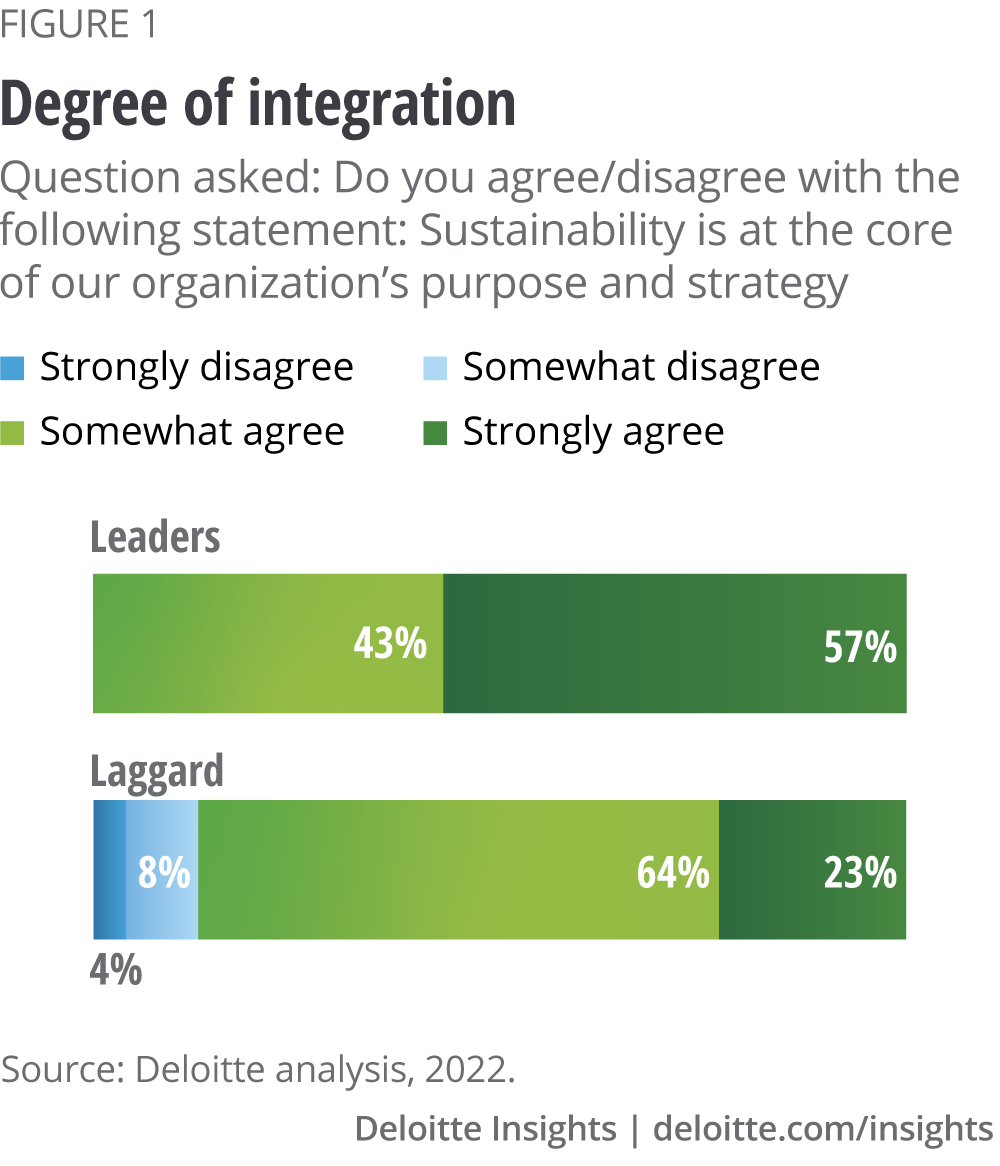
The degree to which business models are impacted by the various ESG issues and resulting transformation needs of their business and operating model varies between sectors. This drives the risk and opportunity landscape of the company and thus their transformation approach:
- Transform to survive—High-impact business models that are at risk of losing their license to operate, such as energy, cement, steel, and chemicals.
- Transform to win—High-impact business models that have an opportunity to differentiate themselves, such as logistics, life sciences, services, and consumer products.
- Transform to transform—High-impact business models that play a critical role in the transformation of their entire business ecosystem, such as machinery, engineering, and financial services.
The second key: Get your transformation fundamentals right
Moving sustainability from the edge to the core also enables companies to leverage their current capabilities to innovate, transform and execute and harness their existing transformation capabilities. Our survey shows precisely that: sustainability leaders succeed by harvesting the business transformation excellence they already have (see our recent Deloitte publications on strategy transformation):5
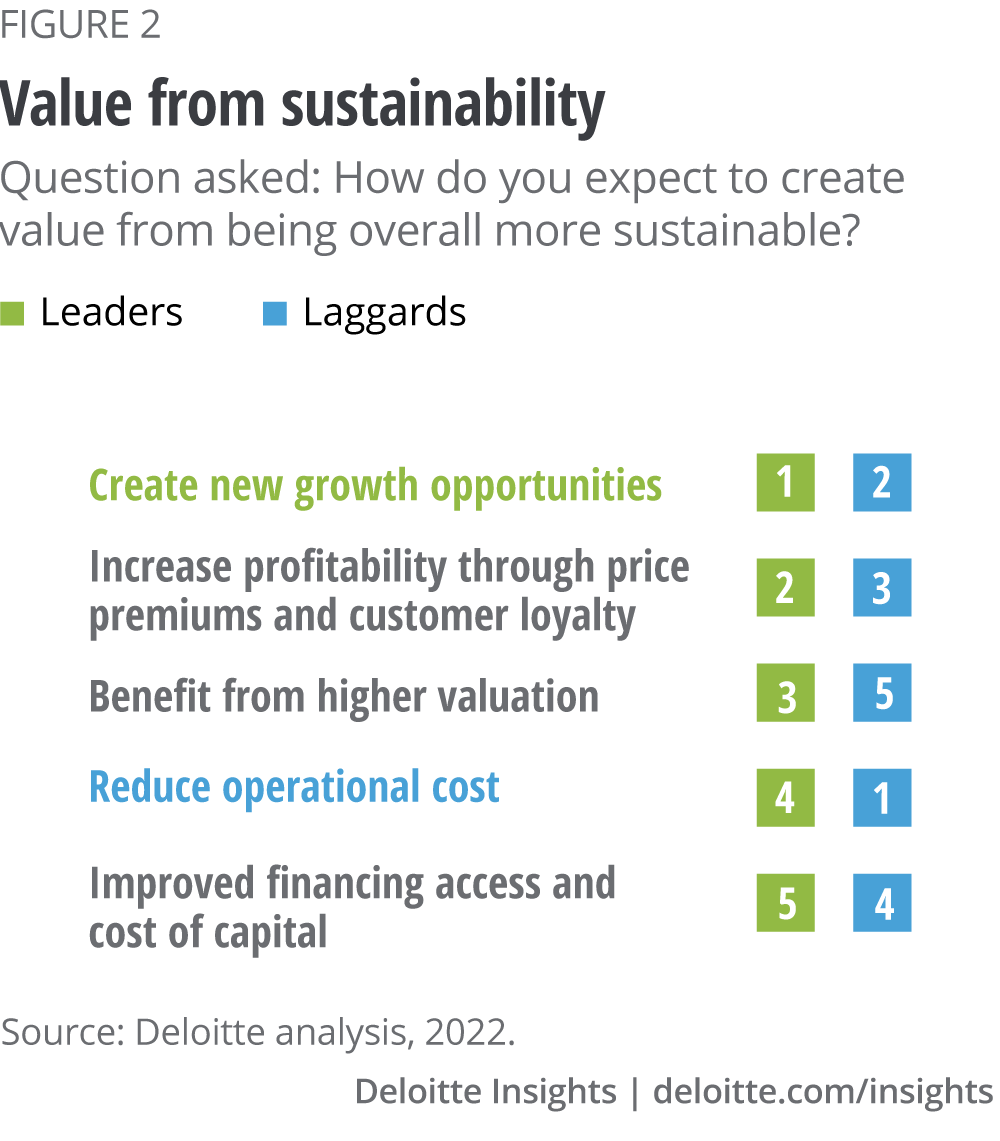
1. Revenue before cost
As part of the three rules published by Michael Raynor in 2014,6 one key determinant of superior long-term success is to drive profitability not by cutting costs but by finding ways to earn higher prices or achieve higher volumes.7 Our research shows that this fundamental principle still holds true in the age of sustainability. Sustainability leaders put a much greater emphasis on opportunities for growth and differentiation than laggards do.
2. Strong transformation capabilities
Transformation has become a constant. A company’s ability to quickly identify and react to change is an essential source of competitive advantage. Therefore, we were not surprised to find that many traditional transformational capabilities scored as being highly important to success in a sustainable business transformation.
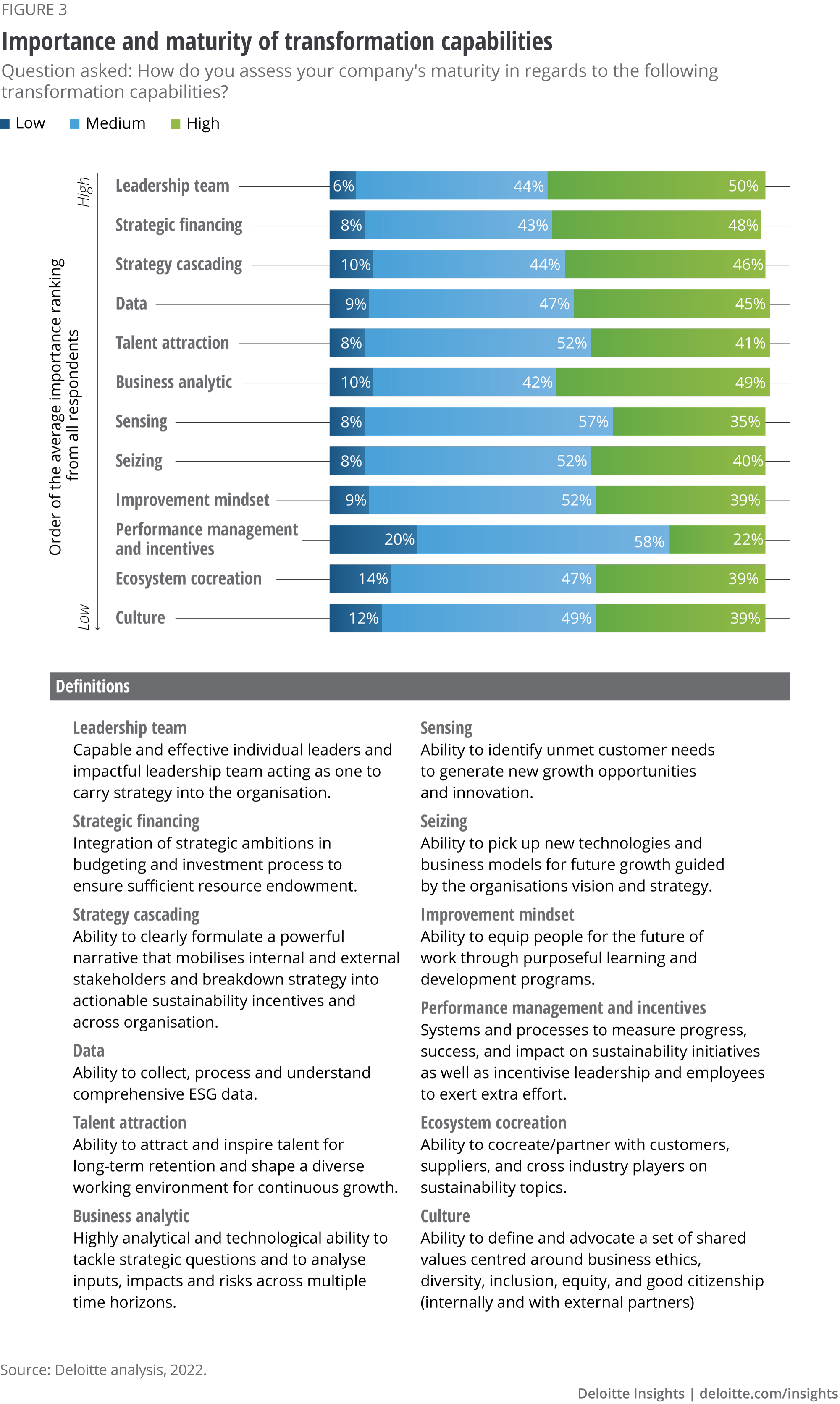
The third key: Strengthen your strategic foresight, ecosystem cocreation and strategy execution
From a managerial perspective many aspects of sustainable business transformation are the same as for prior transformations. But some distinctive differences are required to be successful in this new era of unparalleled complexity and uncertainty.
Central to the sustainability transformation challenge is coping with the exponential increase in external influences, including supply chain complexity, energy cost, employee and societal expectations, and shareholder ambitions. These challenges do not evolve in a linear, unrelated way. Network effects between them drive the need for unprecedented agility and speed.
Sustainable business transformation is not only special due to its complexity, but also because time is running out for humanity to tackle the climate crisis. “We are on a highway to climate hell with our foot on the accelerator,” Antonio Guterres, United Nations general secretary, said at COP27.8 Companies need to act now to have a chance of attaining their climate goals by 2050. However, acting now will require significant investments in unproven technologies today and these investments will have very long payback periods.
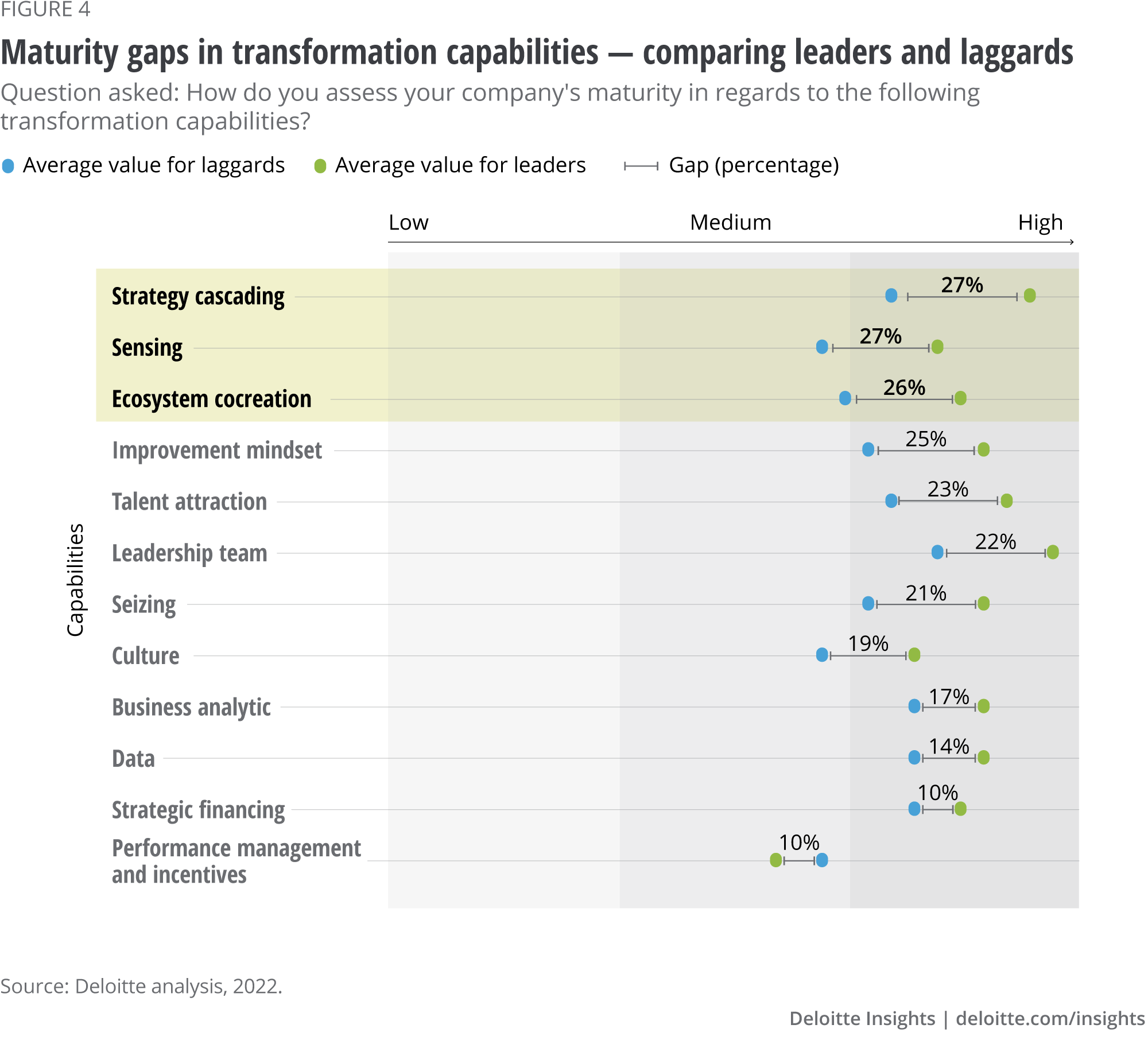
Leaders have a higher maturity than laggards in 11 out of 12 transformation capabilities. That laggards are on par with leaders in “Performance management and incentives” is not surprising as the implementation of sustainability reporting is the starting point for many organizations but by itself not enough to push the needle. Strategic foresight, ecosystem cocreation, and strategy execution are the top three capabilities that set leaders apart from the laggards.
1. Strategic foresight (sensing)—key differentiator to create a resilient organization
First, sustainability leaders systematically gauge their policy and economic environment to anticipate and drive future risks and opportunities. We call this “strategic foresight”.
Organizations which lead in sustainability transformation anticipate the future, are aware of the regulatory, market, and technology shifts taking place and have understood that society’s rising sustainability expectations will shape their business and operating models. The sustainability transformation is largely driven by the external environment and to be on top of it requires a keen awareness of what is happening, sensing any new trends as soon as possible.
As our report results indicate, the sooner an organization builds up its strategic foresight capabilities and the stronger they are, the more likely is it to turn future, disruptive shifts into success factors in their sustainability transformation. It will do this by prioritizing early a range of new business opportunities which are in line with political and societal needs.
To further explore this, please check out the recent publication from Deloitte’s Center for The Long View.9
2. Ecosystem cocreation—Breaking the barriers of the traditional strategic option space
Second, sustainability leaders create strategies and actions with their external business network to achieve the desired pace and scale in their sustainability transformation. We call it “ecosystem cocreation”.

Sustainability leaders transcend their organization’s traditional boundaries to involve their wider business ecosystem, recognizing and analyzing their externalities with external stakeholders along their value chain, such as suppliers and startups. In these times of exponential change, organizations cannot build all the relevant knowledge, skills, technology and influence needed to transform on their own.
Sustainability leaders engage and mobilize their network in two ways: “Outside-in” by leveraging others’ knowledge, skills or technology to efficiently accelerate and de-risk their sustainability transformation; and “inside-out” by leveraging the influence of other, focal organizations in their network to effectively shape the strategies and actions of those around them. In this way organizations can foster a favorable policy and economic environment that enables their own sustainability transformation to succeed.
To address the most pressing sustainability issues in their respective industries and sectors, companies in some cases need to reframe how they think and cooperate with their direct competitors. Forming new alliances with their competitor will be required. Benefits from this cooperation include the sharing of risk and investments related to new and unproven technologies. Organizations in the same industry can complement each other in creating new markets but then compete on dividing up the newly created market. Therefore, if a focal organization benefits from sharing knowledge, skill or technology that creates new business opportunities, it will accept co-opetition if the return from its eventual share of market growth is attractive enough. To support this cooperation, the European Commission has added a new chapter on sustainability agreements to its draft revised Horizontal Guidelines of the European Commission.10
3. Strategy execution—mobilizing not only your own organization but the broader ecosystem
While the challenge to close the strategy-to-execution gap is nothing new,11 sustainability leaders attribute greater importance and display greater maturity in their ability to formulate a powerful narrative that mobilizes internal and external stakeholders and breaks down their strategy into actionable sustainability initiatives.
The special challenge in the context of sustainable business transformation is, as outlined above, that companies must not only mobilize their own organization but also their broader ecosystem. Therefore, the ability to execute in a coordinated way across multiple organizations is a key capability that sustainability leaders apply well.
The fourth key: choose your transformation mode based on your starting position
While 75% of organizations have nominated a CSO or equivalent head of sustainability,12 their respective mandate and execution varies greatly. In our survey we distinguished between four different execution archetypes:
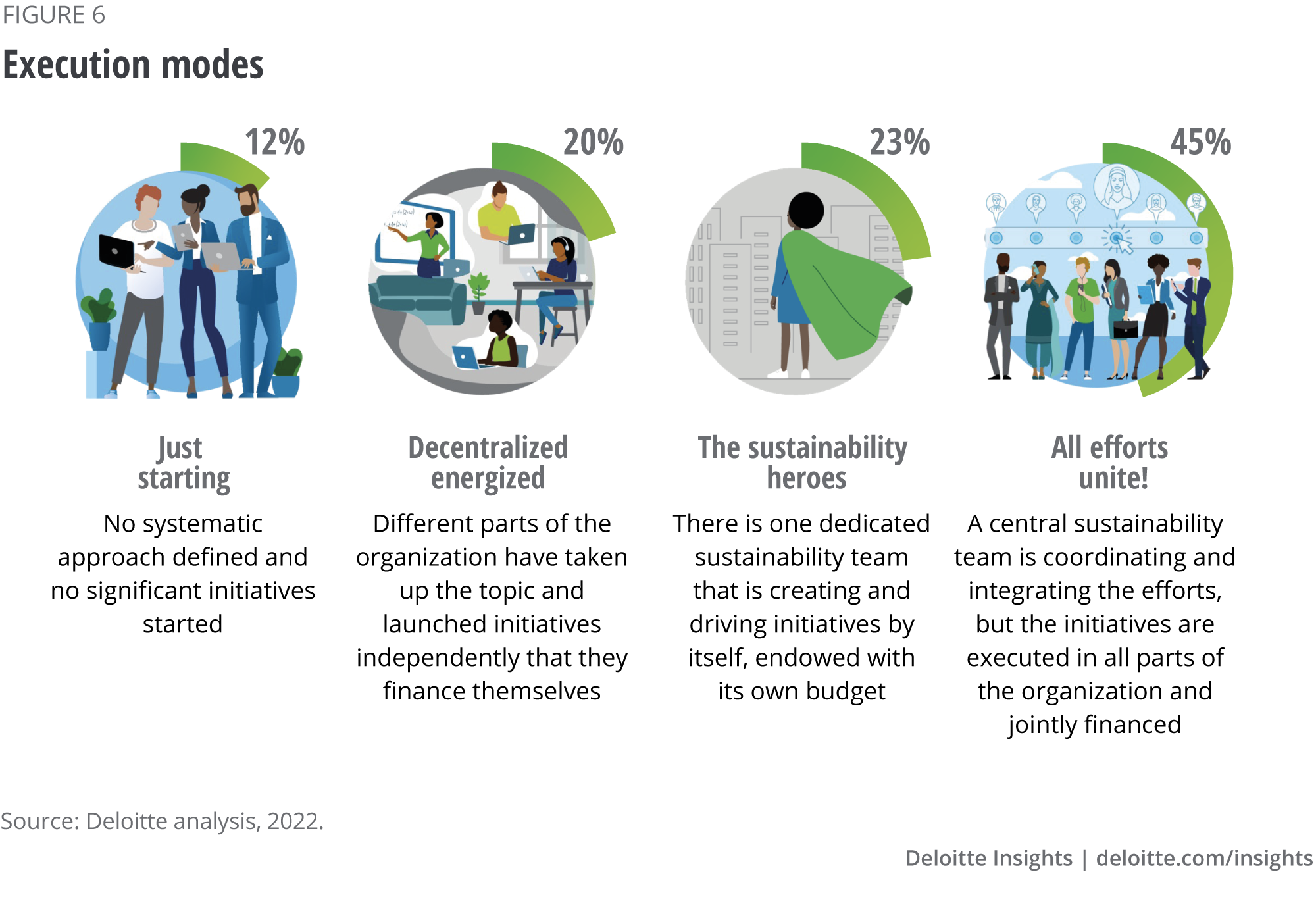
Forty-five percent of respondents choose the “All efforts unite” execution mode in which a central sustainability team coordinates and integrates the sustainability efforts across the organization while the initiatives are executed in a decentralized way. This approach is very much in line with the deployment of a chief transformation officer and central Transformation Nerve Centre that we have seen is a key to success in previous large-scale business transformation programs.13
It has become a consensus that a wide embedding of strategy and transformation into the organization is required to make transformation a success.
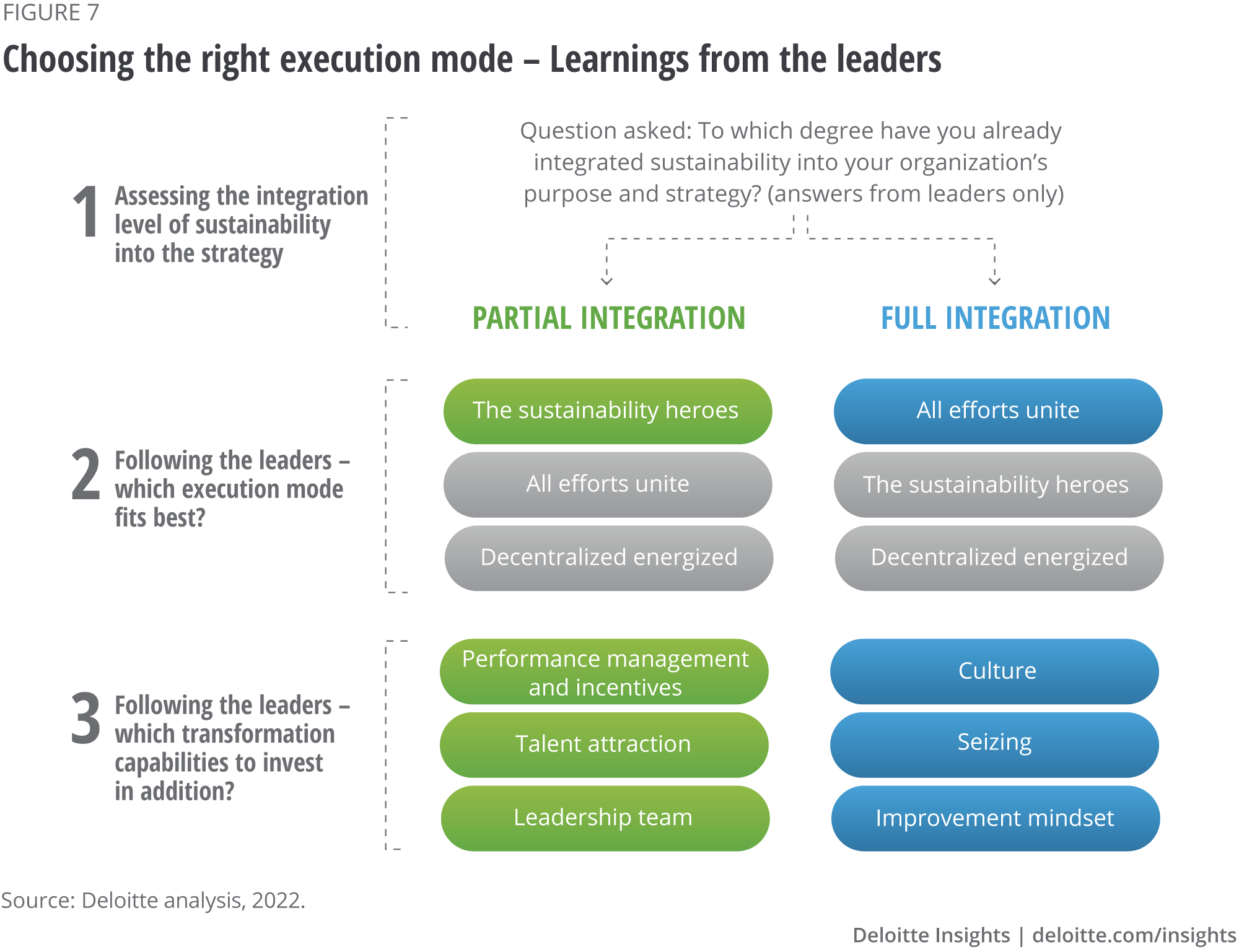
Looking deeper into our survey data, a valuable insight emerges: one size does not fit all. The majority of leaders coming from an intermediate maturity level apply a different execution mode. They have chosen to drive their sustainable business transformation by nominating and empowering a strong central lead and team to drive sustainability across the organization: “the sustainability heroes”.
Therefore, as an executive reflecting on how your organization is currently pursuing its sustainable business transformation, you should start by honestly assessing your current strategic and transformation maturity. Then, carefully choose the execution mode that is the best fit and invest in a focused way in those transformation capabilities that move the needle.
Spotlight: Going digital to speed up the sustainability journey
Data and digital technologies are crucial to sustainable business transformation. They can help reduce greenhouse gas emissions by making business operations more resource-efficient and strengthen resilience to climate-related hazards. They can also improve an organization’s ability to tap advanced intelligence and see clearly its value chain. Digitalization and sustainability will interact and be catalysts for change in the years to come.
“Digitalization will be central in helping companies master their sustainability transformation. On one level, digitalization allows for automated and more efficient processes that directly save energy and raw materials. On a different level, digitalization enables improved simulation, planning, and transparency, greatly benefitting both, environmental and business management. Having accurate, real-time data can help organizations plan appropriately, but continued data growth also bears climate risk, that needs to be thoroughly handled.”
Prof. Dr. Sabina Jeschke – CEO KI Park, CTO Quantagonia GmbH and Former Board Member Deutsche Bahn AG
As outlined under the first key in this article, leading companies recognize that achieving ambitious sustainability goals is not about haphazard, high-visibility initiatives which can easily be seen as greenwashing. A systemic approach to transformation is required, one that processes and understands comprehensive ESG data, analyses inputs, impacts and risks in an advanced way and identifies and addresses unmet customer needs.
To master this, it is essential to integrate technology and data from the start. Companies should therefore ask whether they are bringing next-level technology and digital thinking to the task of meeting sustainability goals—or whether their business transformation lacks an important dimension. There are four main fields in which leaders are using technology effectively to accelerate their sustainability transformation.